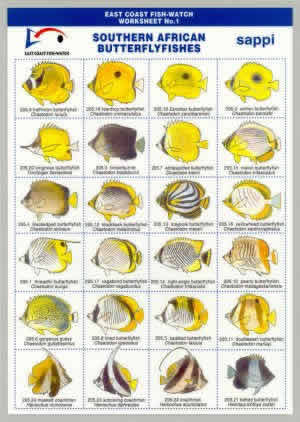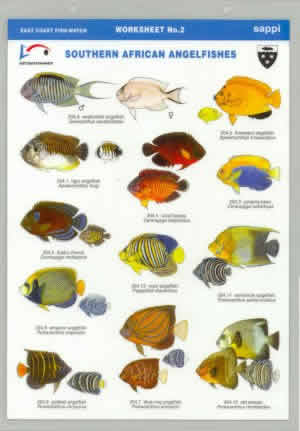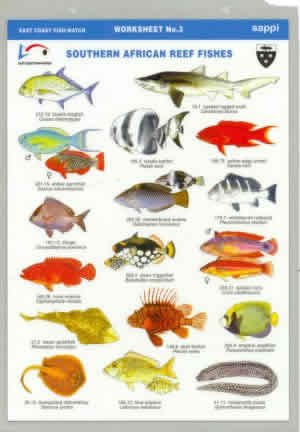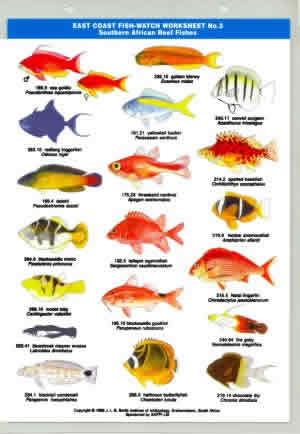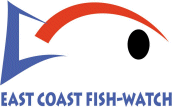

Conducted by

Sponsored by
How to Become a Fish-Watcher
Becoming a Fish-Watcher with the ECFWP is easy, but time demanding. You can start by observing the fish in the tide pools next time you go to the beach. No matter if you are a certified scuba diver or not, your will need a mask, snorkel and fins to help yourself observe them. Getting a fish identification book is a good idea, so you can check the names and descriptions after. A very good one is Coastal Fishes of Souther Africa by Phill and Elaine Heemstra.
Scuba diving is the best way to do fish-watching. This tool will allow you to stay underwater for a long period, increasing the diversity of fishes to watch and the time to familiarize with them. Therefore, if you are willing to improve your fish-watching skills and you are not a certified scuba diver, it is time to start think about taking a Scuba Diver Course. Visit AfricanScuba to choose where to start your career in scuba diving, it is a useful site that consists primarily of an online database of dive companies and dive sites in Africa.
But if you are already a certified scuba diver, the ECFWP offers a fish-watching continuing education system consisting of:
1. Workshops on Fish Identification
A series of courses and lectures, with theory and practical sessions, to learn about the biology and ecology of fishes, and to correctly identify them in situ. Some of the courses are actually scuba diving specialties, so they can be part of your continuing diving education. To know the next workshops check our Fish-Watch Calendar or they can be arranged by appointment with the Manager of the Education Centre at Sea World in Durban.
P.O. Box 10712, Marine Parade 4056
Tel: (031) 337-3536
Fax: (031) 337-2132
2. Fish-Watch Dives
The Fish-Watch Dive is an open ocean training session in fish identification. The Dives are co-ordinated by the charter boat skipper or Dive Master, who presents a short pre-dive briefing to provide some fish observation structure (focus) for that particular dive. This Fish-Watch Dive Plan may be organised along taxonomic lines (a particular family or genus of fishes) that will be the focus of this dive. Alternatively, the Dive Master can pick a particular site (habitat) or ecological category of fishes, e.g., demersal (bottom) fishes, or pelagic (free swimming) fishes as the group for concentration on the dive. During the dive, the code number (from the worksheet) of each species identified should be noted on a slate.
After the dive (on shore), the Dive Master will lead a debriefing session to discuss which species have been identified. Which species were seen, but not recognised (not identified)? Which species were the most common?
To cover the cost of educational materials, divers who want to join a Fish-Watch dive and are not members of the Fish-Watch Project would be asked to join the Project (pay the R50 annual membership fee) or pay a R20 levy (for the Worksheet). Divers who are members of the Project will bring their own worksheets and may do Fish-Watch Dives without paying the extra levy.
Fish-Watch Dives will be launched initially by Blue Wilderness Dive Expeditions. Other dive charter operators may join the Project and offer Fish-Watch Dives, if they comply with the objectives and methods of the Project.
For information on Fish-Watch Dives contact:
Blue Wilderness Dive Expeditions, 9 Hilltop Road, Widenham.
Tel/Fax: (039) 973-2348 Cell: (083) 303 1515
e-mail: info@bluewilderness.co.za
3. Fish-Watch Materials
As part of the Fish-Watch Project we produce 2 Worksheets per year to facilitate fish identification and provide more information about our local fishes. A Worksheet comprises a waterproof underwater fish identification worksheet and several pages of text giving you more information about the fish illustrated on the worksheet.
PRICES:
Worksheets 1-3: R10 each.
Worksheets 4-13: R 20 each
Please add R5.00 for postage.
Send your order to
East Coast Fish Watch, SAIAB
Private Bag 1015, Grahamstown 6140
The worksheets available are:
(N.B. in all cases, to get a larger, higher resolution image, please click on the picture).
2. Southern African Angelfishes: - The reverse side has diagnostic features that separate the angelfish family from other similar fishes that might be mistaken for angelfishes. |
||
3. Common Southern African Reef Fishes: - A double-sided Worksheet showing 36 of the species commonly seen on southern African reefs. |
4. Fishes of the Eastern Cape Province: - A double sided worksheet featuring 34 of the more common Eastern Cape fishes. |
|
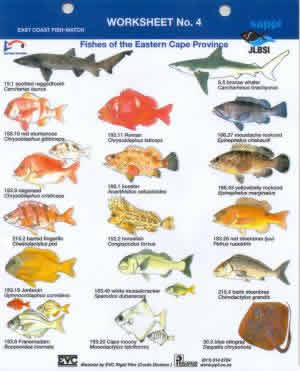  |
||
5. Southern African Triggerfishes: - A double sided worksheet featuring the 20 triggerfish species known from Southern Africa. |
6. Southern African Wrasses - Part 1: - A double sided worksheet featuring 18 of the wrasse species and their juvenile and sexually dichomic color patterns (i.e. the males and females have different colour patterns) known from Southern Africa. |
|
  |
  |
|
7. Southern African Rockcods - Part one: - A double sided worksheet featuring 18 of the rockcods commonly found around Southern Africa and illustrations of juvenile colour patterns where they are different from the adult. |
8. Southern African Hawkfishes and Fingerfins: - A double sided worksheet featuring the 10 species of Hawkfishes and 5 Fingerfins know from Southern Africa. |
|
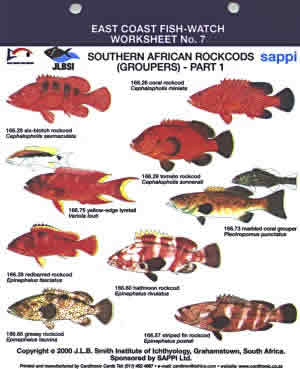 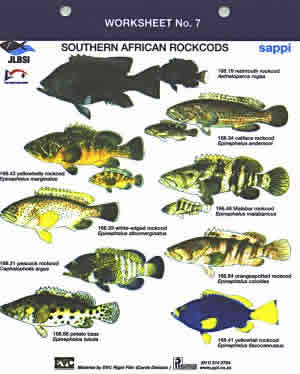 |
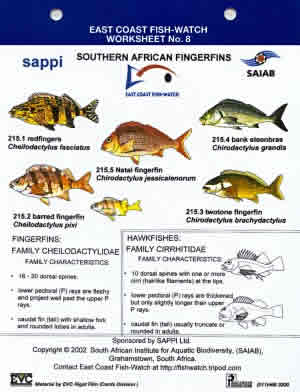  |
|
| 9. Fishes of Aliwal Shoal - Part one: - A double sided worksheet featuring 22 fish species commonly found at Aliwal Shoal. | 10. Southern African Sharks – Part 1. 11. Southern African Wrasses: Family Labridae (Part 2) 12. Southern African Goatfish 13. Southern African Seabream (Sparids) – Part 1 |
|
 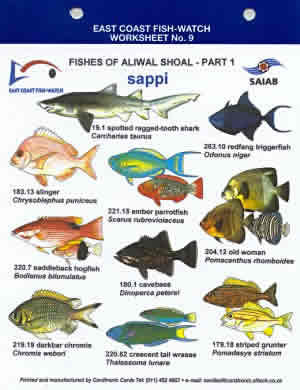 |
||
The Project newsletter (The Fish-Watcher) is an interactive source of information on southern African marine fishes and their identification. It includes new records of fish species from the area, reviews and notices of books and publications concerning our fishes, and progress reports on the fish survey work. We welcome articles, letters, photographs, anecdotes and queries pertaining to marine fishes. We are slowly publishing these online. They can be found by clicking here. |
||
Please note that no images on this or any other page may be reproduced in any form without our written permission.


